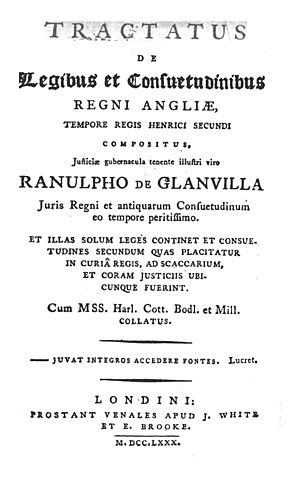Ranulf de Glanvill facts for kids
Quick facts for kids
Ranulf de Glanvill
|
|
|---|---|
| Chief Justiciar of England | |
| In office 1180 – 17 September 1189 |
|
| Monarch | Henry II |
| Preceded by | Richard de Luci |
| Succeeded by | William de Mandeville Hugh de Puiset |
| Sheriff of Lancashire | |
| In office 1173–? |
|
| Monarch | Henry II |
| Sheriff of Yorkshire | |
| In office 1163–1170 |
|
| Sheriff of Yorkshire | |
| In office 1175–? |
|
| Justice of the King's Court | |
| In office 1176–1180 |
|
| Personal details | |
| Born | c. 1112 Stratford St Andrew, Suffolk |
| Died | 1190 Acre, Palestine |
| Relations | Hubert Walter, nephew |
Ranulf de Glanvill (who also used names like Glanvil or Glanville) was a very important person in England. He was the Chief Justiciar (like a top judge and royal advisor) for King Henry II from 1180 to 1189. He is also thought to have written the first book about English laws, called Tractatus de legibus et consuetudinibus regni Anglie (which means The Treatise on the Laws and Customs of the Kingdom of England).
Contents
Ranulf de Glanvill's Early Life and Career
We don't know exactly when or where Ranulf de Glanvill was born. The first time we hear about him is when he was a Sheriff in Yorkshire, Warwickshire, and Leicestershire. He held these roles from 1163 to 1170. After this, he was no longer in those positions.
Becoming a Royal Official
In 1173, Ranulf was appointed Sheriff of Lancashire. A sheriff was a powerful official who managed a county for the king. In 1174, while he was the Sheriff of Westmorland, he played a key role in the Battle of Alnwick. At this battle, the King of Scotland, William the Lion, surrendered to the English leaders, including Ranulf.
Rising to Chief Justiciar
Ranulf continued to rise in power. In 1175, he became Sheriff of Yorkshire again. By 1176, he was a judge in the king's court and traveled to different areas as a judge. In 1180, he reached the highest legal position: Chief Justiciar of England.
As Chief Justiciar, Ranulf was King Henry II's most trusted helper. He helped the king make important changes to the legal system. When King Henry was away from England, Ranulf was in charge of the country. In 1176, he was also given the job of looking after Queen Eleanor, who was living in Winchester Castle.
End of His Career and Life
After King Henry II died in 1189, his son Richard I became king. Richard removed Ranulf from his job on September 17, 1189. Ranulf was held captive until he paid a large sum of money to be set free. Soon after, he joined the Crusades, which were religious wars. He died in 1190 during the siege of Acre in the Middle East.
Ranulf's Religious Contributions
Ranulf de Glanvill also founded two monasteries in Suffolk, England. In 1171, he founded Butley Priory for a group of monks called the Black Canons. In 1183, he founded Leiston Abbey for the White Canons. He also built a hospital for people with leprosy in Somerton, Norfolk.
Ranulf's Family Life
Ranulf de Glanvill married a woman named Bertha de Valoignes. She was the daughter of Theobald de Valoines, who was a lord of the manor in Parham, Suffolk. Ranulf and Bertha had three daughters:
- Matilda (Maud) de Glanville: She married Sir William de Auberville. They founded Langdon Abbey in Kent.
- Ammabil (Mabel) de Glanville: She married a man from the de Arden family.
- Helewis de Glanville: She married Robert fitz Ralph fitz Ribald. She founded Swainby Abbey, which later moved to Coverham Abbey in North Yorkshire.
What Was the Tractatus de legibus?
Ranulf de Glanvill either wrote or helped create the book Tractatus de legibus et consuetudinibus regni Anglie. This book is often simply called Glanvill. It was a very important book because it described how the king's court worked and explained the old laws and customs of England. It gives us a lot of information about how the legal system began in England.
The Tractatus was first printed in 1554. Later, it was translated into English in 1812. Many people believe Ranulf was the main author, but some think his nephews, Hubert Walter (who also became a Chief Justiciar) and Osbert fitzHervey, might have helped write it.


